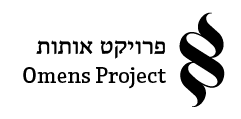The Hebrew alphabet is one of the most ancient in the world, we can still find inside it remnants of codes embedded from patterns of phinique, ashuric, and proto Canaanite – that are believed to be the first phonetic languages. The uniqueness here, is that the Hebrew alphabet is still in use – now, more than ever. From ancient times, and up to this day still – the Hebrew alphabet is undergoing a process of continuous evolution. In the early days of Hebrew – it was carved into to stone – and with the invention of the quill pen, the letters changed their form and style. Those same letters written with a quill pen have not change so much since the invention of this amazing tool – but if you look closely you will notice that nowadays the letters have become simpler and clearer – making reading more convenient and comfortable.
To this modern form of letters, we cannot credit any creator, or even culture – just like rocks on the beach that change their form by the waves of history crashing upon them over the centuries, the letters grow and shift with every person that perceives them or paints them into existence. Over the years it seems as though the form of the letters sharpen and stabilize – as if they had a mind of their own.
Along with the Hebrew alphabet, there are other
languages that evolved and are still in use, while the main commonality is the
tool of writing – the quill pen, like Arabic and devangari (Hindu).
Look at the similarities and differences – the Arabic writing is down to earth,
while the devangari is high in the sky – and the Hebrew is balanced and square.

It is interesting to observe the style of writing with the attributes of a culture, like a work of art can shine light on the artist’s personality, we could analyze an alphabet with a similar approach. In the process of creating the deck, we worked with the hypothesis that the bottom line symbolizes the ground, the upper line the sky – and that helped us navigate in the symbolic realms of meaning – to interpret these enigmatic symbols that influence our lives so much.
